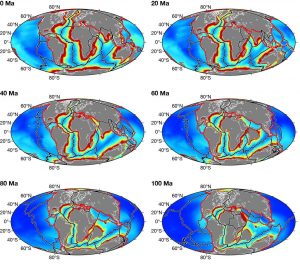Tracing sedimentation through time on existing and vanished seafloor is imperative for constraining long-term eustasy and for calculating volumes of subducted deep-sea sediments that contribute to global geochemical cycles. We present regression algorithms that incorporate the age of the ocean crust and the mean distance to the nearest passive margin to predict sediment thicknesses and long-term decompacted sedimentation rates since 200 Ma. The mean sediment thickness decreases from ∼220 m at 200 Ma to a minimum of ∼140 m at 130 Ma, reflecting the replacement of old Panthalassic ocean floor with young sediment-poor mid-ocean ridges, followed by an increase to ∼365 m at present-day. This increase reflects the accumulation of sediments on ageing abyssal plains proximal to passive margins, coupled with a decrease in the mean distance of any parcel of ocean crust to the nearest passive margin by over 700 km, and a doubling of the total passive margin length at present-day. Mean long-term sedimentation rates increase from ∼0.5 cm/k.y. at 160 Ma to over 0.8 cm/k.y. today, caused by enhanced terrigenous sediment influx along lengthened passive margins, superimposed by the onset of ocean-wide carbonate sedimentation. Our predictive algorithms, coupled to a plate tectonic model, provide a framework for constraining the seafloor sediment-driven eustatic sea-level component, which has grown from ∼80 m to 210 m since 120 Ma. This implies a long-term sea-level rise component of 130 m, partly counteracting the contemporaneous increase in ocean basin depth due to progressive crustal ageing.

Animations for this paper can be found on the EarthByte youtube channel:
https://www.youtube.com/watch?v=MLfQM_on8jo
https://www.youtube.com/watch?v=P2HbVt4_Gk0
You can also access the supplementary data from here:
https://www.earthbyte.org/webdav/ftp/Data_Collections/Dutkiewicz_etal_2017_G3/
and the workflows from here:
https://github.com/EarthByte/predicting-sediment-thickness
![]()
